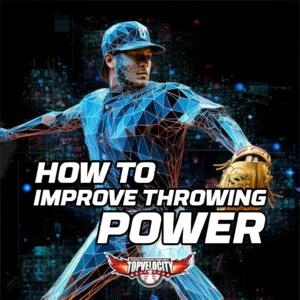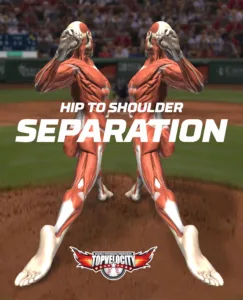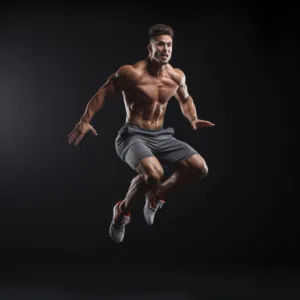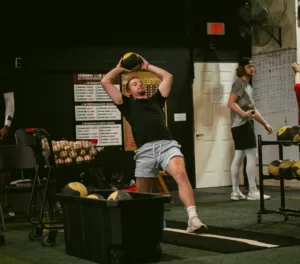 Are you searching How to Improve Throwing Power but hitting a brick wall? Perhaps you've tried a few training regimens or strategies but are still unable to overcome your restrictions. If this describes you, you are far from alone. The desire for better throwing power is a frequent goal for many athletes, particularly those in baseball. A powerful arm might be your most valuable tool, whether you're a pitcher seeking to dominate the mound or a position player looking to make those long throws from the outfield.
Are you searching How to Improve Throwing Power but hitting a brick wall? Perhaps you've tried a few training regimens or strategies but are still unable to overcome your restrictions. If this describes you, you are far from alone. The desire for better throwing power is a frequent goal for many athletes, particularly those in baseball. A powerful arm might be your most valuable tool, whether you're a pitcher seeking to dominate the mound or a position player looking to make those long throws from the outfield.
TopVelocity's 3X and 2X Velocity Programs offer a scientific approach to skill growth to help you along your journey. These programs have been precisely designed to not only improve your natural throwing ability but also to reduce your chance of injury. Athletes of all skill levels have found these programs to be invaluable in their growth. In this detailed post, we will walk you through the ins and outs of increasing your throwing power with the 3X and 2X Velocity Programs. Prepare to up your game and get the velocity you've always desired.
The Science of How to Improve Throwing Power
- Biomechanics: An Introduction
Throwing biomechanics require a complicated interaction of multiple muscle groups, joints, and bones. Understanding these connections is critical if you want to improve your throwing power. Knowing how your body functions can provide you with the tools you need to maximize your training and achieve lasting changes. - The Movement of Energy in the Body
During the throwing motion, energy is transported from the legs to the torso and then to the arm. This energy chain is critical for maximizing throwing power. Learning how to access this stored energy can be game-changing for sportsmen trying to increase their throwing velocity.
Impact of Pelvis and Trunk Biomechanics on Pitching Velocity
 Orishimo et al., (2023) set out to investigate how the biomechanics of the pelvis and trunk contribute to ball velocity during baseball pitching. The researchers concentrated on three primary factors: pelvic rotation velocity, trunk rotation velocity, and hip-shoulder separation at the point of foot impact. The study included 29 male pitchers aged 17 and above from high school and college. Their fastball pitching mechanics were meticulously documented.
Orishimo et al., (2023) set out to investigate how the biomechanics of the pelvis and trunk contribute to ball velocity during baseball pitching. The researchers concentrated on three primary factors: pelvic rotation velocity, trunk rotation velocity, and hip-shoulder separation at the point of foot impact. The study included 29 male pitchers aged 17 and above from high school and college. Their fastball pitching mechanics were meticulously documented.
The average ball velocity was 33.5 2.8 ms1 and the average hip-shoulder separation at foot contact was around 50°, according to the study. Peak trunk velocity was found to be a significant predictor of ball velocity. Specifically, peak trunk velocity alone could account for around 25% of the variability in ball velocity. No combination of the parameters investigated could explain the diversity in ball velocity any further. Individual components such as hip-shoulder separation at foot contact, peak pelvis velocity, and peak pelvis velocity timing were found to be predictive of peak trunk velocity on a more granular level. In fact, these variables explained 55% of the variation in trunk rotation velocity.
What does this all imply for athletes and coaches? Simply expressed, the study emphasizes the importance of pelvic and trunk biomechanics in pitching ball velocity generation. Training regimens focused at improving "axial dissociation" (the ability to move these body parts independently but in a coordinated manner) between the pelvis and the trunk could considerably boost ball velocity. The best thing is that this may be accomplished without adding additional training load to the shoulder and elbow, lowering the chance of injury.
Relationship Between Lower Extremity Power and Pitching Performance
 Wong et al., led the 2023 study to better understand the impact of lower extremity power on fastball spin rate and ball velocity in professional baseball pitchers. The study included 53 asymptomatic professional pitchers who were subjected to a battery of jump tests, including countermovement jumps (CMJ), squat jumps (SJ), and drop jumps (DJ). During a competitive season, their fastball spin rate and ball velocity were measured utilizing 3-dimensional Doppler radar and video systems.
Wong et al., led the 2023 study to better understand the impact of lower extremity power on fastball spin rate and ball velocity in professional baseball pitchers. The study included 53 asymptomatic professional pitchers who were subjected to a battery of jump tests, including countermovement jumps (CMJ), squat jumps (SJ), and drop jumps (DJ). During a competitive season, their fastball spin rate and ball velocity were measured utilizing 3-dimensional Doppler radar and video systems.
The study discovered a substantial relationship between the sum of CMJ and SJ characteristics (such as peak force, peak power, and rate of power development) and ball spin rate. However, no single variable demonstrated a substantial association. None of the factors in CMJ or SJ exhibited a meaningful connection with ball velocity. Surprisingly, the study discovered that the total of DJ factors caused a large variation in ball velocity. The reactive strength index, in particular, was the sole component that contributed significantly to this model. This implies that increasing lower extremity power, as measured by the DJ test, has the potential to raise both fastball spin rate and ball velocity. This study supports the notion that pitchers who want to improve their performance measures should prioritize lower extremity training.
What is the 3X Velocity Program?
- The Fundamental Ideas
The 3X Velocity Program is a series of scientifically tested exercises, lifts, and drills that are meant to increase throwing power. This program combines plyometric exercises, weight training, and specialized throwing drills. - Program Elements
Specific warm-up sessions, main training sets, and recuperation regimens are among the components. This holistic strategy ensures that you are fully equipped to face difficulties and recover effectively afterward.
What is the 2X Velocity Program?
- The Fundamentals
The 2X Velocity Program, like the 3X, emphasizes on throwing power but focuses more on position-specific skills. This curriculum is perfect for athletes who play more than one position on the field, such as pitchers. - The distinction between 3X and 2X
While both programs strive to develop throwing power, the 2X Velocity Program adapts the 3X principles to position players. The format is the same but specifically built for position players' throwing principles.
Why Should You Choose 3X and 2X Velocity Programs?
- Safety precautions
One of the most important advantages of these programs is their emphasis on lowering the risk of harm. This is critical because injuries can greatly impede an athlete's progress. The programs include scientifically supported training approaches that seek to improve performance while keeping you safe. - Metrics of Performance
TopVelocity tracks your development using advanced analytics and performance indicators. This data-driven method might assist you in fine-tuning your training plan for the best results.
How to Improve Throwing Power NOW!
 Are you ready to reach your best potential on the field? With our scientifically supported training regimens, you can stop settling for average and become an outstanding athlete. We have the ideal program for you whether you're a pitcher trying to fire up your fastball or a position player looking to improve your game.
Are you ready to reach your best potential on the field? With our scientifically supported training regimens, you can stop settling for average and become an outstanding athlete. We have the ideal program for you whether you're a pitcher trying to fire up your fastball or a position player looking to improve your game.
Our 3X Velocity Camp is a game-changer for pitchers. You'll have unique access to cutting-edge training programs that use biomechanics, physiology, and sports science to improve your throwing velocity while simultaneously lowering your risk of injury. The 2X Velocity Camp will help position players improve their fielding, throwing, and hitting abilities. Experience training methods based on the most recent sports science research to enhance your natural abilities and prevent injuries.
Don't pass up the opportunity to be a part of these premier programs. Spots are filling up quickly, and you won't want to miss out on the chance to take your game to the next level. Make the choice today that your future self will appreciate. Sign up now for either the 3X Velocity Camp for Pitchers or the 2X Velocity Camp for Position Players by clicking the link below. Let's make your aspirations a reality!
Sign up for the 3X Velocity Pitcher Camp!
Register for the 2X Velocity Camp for Position Players!
Join the TopVelocity Patreon for more exclusive content like this with remoting coaching and weekly video analysis!
FAQs: How to Improve Throwing Power
- What do I need to participate in the 3X and 2X Velocity Programs?
For starters, you'd need a set of resistance bands, a medicine ball, and a good pitching mound. - How long does it take to see a difference?
It usually takes 6-8 weeks of consistent training to see noticeable results. - Is the software appropriate for beginners?
Absolutely. The 3X and 2X Velocity Programs can be tailored to athletes of varying ability levels. - Can I participate in these programs from home?
Yes, but having access to a gym would give you a wider selection of training possibilities. - Do I require the services of a personal coach?
While having a coach is not required, it can give you with useful insights and tailored support. - Is there an age limit for these programs?
These regimens are appropriate for athletes as young as 13, but it is always best to seek specific counsel from a healthcare expert.
Reference:
Orishimo, K. F., Kremenic, I. J., Mullaney, M. J., Fukunaga, T., Serio, N., & McHugh, M. P. (2023). Role of Pelvis and Trunk Biomechanics in Generating Ball Velocity in Baseball Pitching. Journal of Strength and Conditioning Research, 37(3), 623-628.
Wong, R., Laudner, K., Amonette, W., Vazquez, J., Evans, D., & Meister, K. (2023). Relationships Between Lower Extremity Power and Fastball Spin Rate and Ball Velocity in Professional Baseball Pitchers. Journal of Strength and Conditioning Research, 37(4), 823-828.




